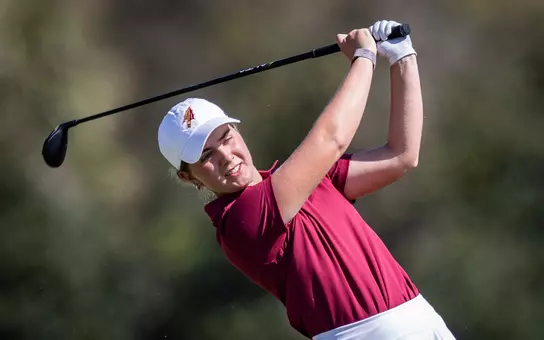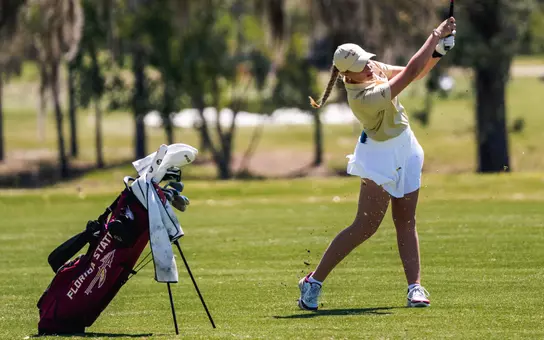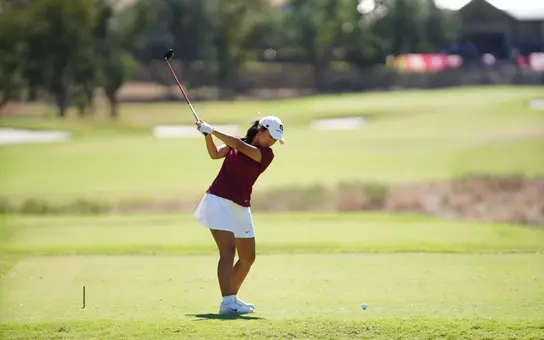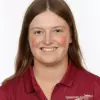Florida State University Athletics
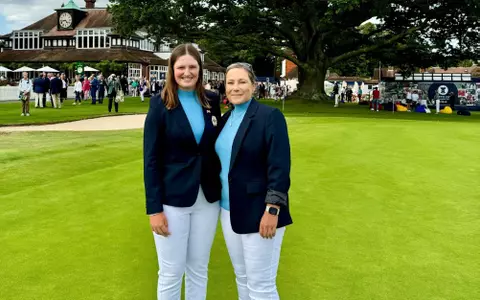
Hall Of Famer Stupples, All-American Woad At Curtis Cup
8/30/2024 9:04:00 AM | Women's Golf
SUNNINGDALE, England -- Karen Stupples is an All-American, and a two-time All-ACC selection, who won two individual championships and led the Seminoles to four tournament championships during her two-year career as a Seminole (1994 and 1995).
Stupples won twice on the LPGA Tour – the 2004 Welch's/Fry Championship and the 2004 Weetabix Women's British Open – and enjoyed a 15-year career on the tour. She earned nearly $4 million during her career on the LPGA and Ladies European Tours over the course of her 15-year career.
She can be found (and heard) as she joined the Golf Channel in 2013 and currently serves as an on-course reporter and analyst for the network's LPGA TOUR live tournament coverage. Stupples also contributes to the network's coverage of the NCAA Championships and called former Florida State All-American Morgane Metraux's exciting play in the 2024 Paris Olympics.
Stupples will coach Florida State All-American Lottie Woad as an Assistant Captain for the Great Britain and Ireland team in the Curtis Cup (Aug. 30-Sept 1, 2024) at Sunningdale Golf Club in England.
Stupples sat down with Seminoles.com during the Paris Olympics to discuss her golfing career, her television career, and her beloved Florida State Seminoles.
Seminoles.com: How did your extremely successful golf career on the LPGA Tour help you become one of the lead announcers for Golf Channel and NBC Sports?
KS: In 2007, I had my son Logan and the BBC asked me to do some radio work for them. I really enjoyed being part of the media, I enjoyed the debates about the golf and course. I really enjoyed that experience, and then in 2013, I realized that I had had enough of playing and needed a plan B. Since I had such a good experience with the BBC, I thought I should see if TV was an option. Beth Hutter was the producer for the LPGA Tour coverage at the time and she was happy to let me try – I tagged along and put a headset on, sat around the production trucks, and felt like I could do it pretty well. A few weeks later, she asked if I'd be willing to try as an on-course reporter. I thought I'd be shadowing that week, but they actually needed a third reporter, so I ended up on-air and I'm still here.
Seminoles.com: You've made a seamless transition from being an on-course reporter to one of the channels top analysts. Is that a natural progression and is it something you set for as a goal for yourself?
KS: When I started out for GOLF Channel, I did both – I would step into the booth in place of Judy Rankin every once in a while, but also would go on-course. I split my time on-course and in the booth. It really wasn't anything I had set up for as a goal, I just wanted to work in TV and have a chance to talk about golf and still feel like I was a part of the tour and competitive golf as opposed to dealing with the pressures and stresses of playing and having it all on me. It wasn't really a goal, and it was something that I was thrown into both roles straight away.
Seminoles.com: What are the fun differences and challenges both positions – on course color analyst and top analysts -- pose?
KS: It's quite interesting and I enjoy them both. I would say the challenges on-course are in order to be part of the show, you have to rely on the audio cues for what's going on. You don't see the TV show, you are only seeing your group. You have to rely on the producer cues, the booth cues. You have to constantly creating the picture in your head as you're going around the golf course as to what the viewer is seeing. You have to listen incredibly closely to the show to do the job well, but only worry about your three players and you call golf as you see it. When you're in the booth, it's very different. You can see everything on the monitor, but you have to cover everything. You have to be aware of everything going on the golf course, not just your group. You have to know all of the players, you have to think on your feet, you have to have an answer for everything, and you have to apply the "how's" and the "whys" very quickly and efficiently. How did it happen and why did it happen? Both have a lot of appeal to me, and they are very different and difficult in their own way.
Seminoles.com: What's more challenging – preparing for an event as a golfer or preparing for an event as an analyst?
KS: Preparing as a golfer! You spend years and years training and preparing for your tournaments. I spend three or four days preparing for a broadcast. It is hard to compare the two, but I do feel like being on live on TV gives you the same adrenaline rush as playing.
Seminoles.com: What were some of the challenges of making the transition from being one of the players to being a member of the media?
KS: For me, the biggest challenge was having to ask the questions. Even when you're the analyst, you are still being asked questions from your host – so I would say asking the questions as opposed to answering the questions was the biggest challenge.
Seminoles.com: What are some of the things you have worked on to gain the trust of the players who you now broadcast across so many platforms?
KS: You have to earn their respect, and they respect you as a player and they understand that you've been what they've been through. I feel like they trust me because I'm very thoughtful with my questions and I'm very honest as it relates to my comments about their game. I always ask myself, 'If someone had said this about my own game, would it be a fair comment?' I always try and be very fair whether it's good or bad. It's OK to be critical and it's OK to sing their praises too, but you have to be very honest, and I think the players respect me because of that.
Seminoles.com: Telling stories has to be an important part of your job as a broadcaster. How do you come up with ideas to be able to tell the real-life stories of the golfers you cover?
KS: I don't sit at home and think, 'What am I going to say this week?' But the stories and ideas come to me, and they come to all of us when we are together at the tournaments talking to the players, talking to relatives, etc. General chats when you are walking around the course and bump into people. Those are when those ideas jump out, because its relevant at that time. That's where you pick up the most interesting stories."
Seminoles.com: How much do you utilize your real-life experiences as a golfer to make you a better analyst?
KS: When I'm out on the course, I still feel the shots as if I were playing them. I still feel it inside how I would have felt if I were standing over the shot. I still feel the same amount of nerves, I still feel it as if I were playing it. The fact that I've been in their shoes, I'm able to verbalize how I would have felt in their positions. Some people are built differently, but I do feel like that gives me a good idea of what's going on with the players.
Seminoles.com: Your travel schedule must be ridiculous – was travel easier as a player and how do you travel as a member of the television crew? How much of a support has your family been?
KS: Travel as a commentator is much easier. I don't have to worry about golf clubs! I'm a one suitcase kind of person these days and there's no waiting for them at the oversize baggage counter and crossing my fingers to see if my clubs made the trip. Working with NBC and GOLF Channel make the travel process fantastic. Everything about my travel now is a lot more comfortable than I had it when I played.
Seminoles.com: As a Florida State Hall of famer, have you been back to see the new Seminole Legacy Golf Course design? Have you played the new Nicklaus design on campus?
KS: I have not – I've seen the new facility; I've been there but I have not yet been on the course itself. I know that everyone raves about it and I'm proud to have been a part of Florida State golf history. I'm very proud of the current players they have coming through the program and of what Amy Bond and Trey Jones are doing with both of the programs. They do a really fantastic job and there's no doubt that the new facility helps bring the very best recruits on board.
Seminoles.com: Certainly, you've seen Florida State's Lottie Woad – what are your thoughts on her progression in the game of golf after having completed only her sophomore season as a Seminole?
KS: I think Lottie Woad is one of those special talents. She does things that not everyone can do. Think back to the Augusta National Women's Amateur – to hole four putts in those last few holes that meant the difference in her winning or not winning...to hole one when it matters is huge, but to be able to hole four? That's a whole different zip code when it comes to excellence. She continues to produce the goods when it really matters. No amount of practice on a driving range can make a difference when it comes to that. She has the intangibles that the best champions have. It's pretty fun watching Lottie do what Lottie does and for her only to be a sophomore has to be pretty exciting for Amy (Bond) and the whole program."
Stupples won twice on the LPGA Tour – the 2004 Welch's/Fry Championship and the 2004 Weetabix Women's British Open – and enjoyed a 15-year career on the tour. She earned nearly $4 million during her career on the LPGA and Ladies European Tours over the course of her 15-year career.
She can be found (and heard) as she joined the Golf Channel in 2013 and currently serves as an on-course reporter and analyst for the network's LPGA TOUR live tournament coverage. Stupples also contributes to the network's coverage of the NCAA Championships and called former Florida State All-American Morgane Metraux's exciting play in the 2024 Paris Olympics.
Stupples will coach Florida State All-American Lottie Woad as an Assistant Captain for the Great Britain and Ireland team in the Curtis Cup (Aug. 30-Sept 1, 2024) at Sunningdale Golf Club in England.
Stupples sat down with Seminoles.com during the Paris Olympics to discuss her golfing career, her television career, and her beloved Florida State Seminoles.
Seminoles.com: How did your extremely successful golf career on the LPGA Tour help you become one of the lead announcers for Golf Channel and NBC Sports?
KS: In 2007, I had my son Logan and the BBC asked me to do some radio work for them. I really enjoyed being part of the media, I enjoyed the debates about the golf and course. I really enjoyed that experience, and then in 2013, I realized that I had had enough of playing and needed a plan B. Since I had such a good experience with the BBC, I thought I should see if TV was an option. Beth Hutter was the producer for the LPGA Tour coverage at the time and she was happy to let me try – I tagged along and put a headset on, sat around the production trucks, and felt like I could do it pretty well. A few weeks later, she asked if I'd be willing to try as an on-course reporter. I thought I'd be shadowing that week, but they actually needed a third reporter, so I ended up on-air and I'm still here.
Seminoles.com: You've made a seamless transition from being an on-course reporter to one of the channels top analysts. Is that a natural progression and is it something you set for as a goal for yourself?
KS: When I started out for GOLF Channel, I did both – I would step into the booth in place of Judy Rankin every once in a while, but also would go on-course. I split my time on-course and in the booth. It really wasn't anything I had set up for as a goal, I just wanted to work in TV and have a chance to talk about golf and still feel like I was a part of the tour and competitive golf as opposed to dealing with the pressures and stresses of playing and having it all on me. It wasn't really a goal, and it was something that I was thrown into both roles straight away.
Seminoles.com: What are the fun differences and challenges both positions – on course color analyst and top analysts -- pose?
KS: It's quite interesting and I enjoy them both. I would say the challenges on-course are in order to be part of the show, you have to rely on the audio cues for what's going on. You don't see the TV show, you are only seeing your group. You have to rely on the producer cues, the booth cues. You have to constantly creating the picture in your head as you're going around the golf course as to what the viewer is seeing. You have to listen incredibly closely to the show to do the job well, but only worry about your three players and you call golf as you see it. When you're in the booth, it's very different. You can see everything on the monitor, but you have to cover everything. You have to be aware of everything going on the golf course, not just your group. You have to know all of the players, you have to think on your feet, you have to have an answer for everything, and you have to apply the "how's" and the "whys" very quickly and efficiently. How did it happen and why did it happen? Both have a lot of appeal to me, and they are very different and difficult in their own way.
Seminoles.com: What's more challenging – preparing for an event as a golfer or preparing for an event as an analyst?
KS: Preparing as a golfer! You spend years and years training and preparing for your tournaments. I spend three or four days preparing for a broadcast. It is hard to compare the two, but I do feel like being on live on TV gives you the same adrenaline rush as playing.
Seminoles.com: What were some of the challenges of making the transition from being one of the players to being a member of the media?
KS: For me, the biggest challenge was having to ask the questions. Even when you're the analyst, you are still being asked questions from your host – so I would say asking the questions as opposed to answering the questions was the biggest challenge.
Seminoles.com: What are some of the things you have worked on to gain the trust of the players who you now broadcast across so many platforms?
KS: You have to earn their respect, and they respect you as a player and they understand that you've been what they've been through. I feel like they trust me because I'm very thoughtful with my questions and I'm very honest as it relates to my comments about their game. I always ask myself, 'If someone had said this about my own game, would it be a fair comment?' I always try and be very fair whether it's good or bad. It's OK to be critical and it's OK to sing their praises too, but you have to be very honest, and I think the players respect me because of that.
Seminoles.com: Telling stories has to be an important part of your job as a broadcaster. How do you come up with ideas to be able to tell the real-life stories of the golfers you cover?
KS: I don't sit at home and think, 'What am I going to say this week?' But the stories and ideas come to me, and they come to all of us when we are together at the tournaments talking to the players, talking to relatives, etc. General chats when you are walking around the course and bump into people. Those are when those ideas jump out, because its relevant at that time. That's where you pick up the most interesting stories."
Seminoles.com: How much do you utilize your real-life experiences as a golfer to make you a better analyst?
KS: When I'm out on the course, I still feel the shots as if I were playing them. I still feel it inside how I would have felt if I were standing over the shot. I still feel the same amount of nerves, I still feel it as if I were playing it. The fact that I've been in their shoes, I'm able to verbalize how I would have felt in their positions. Some people are built differently, but I do feel like that gives me a good idea of what's going on with the players.
Seminoles.com: Your travel schedule must be ridiculous – was travel easier as a player and how do you travel as a member of the television crew? How much of a support has your family been?
KS: Travel as a commentator is much easier. I don't have to worry about golf clubs! I'm a one suitcase kind of person these days and there's no waiting for them at the oversize baggage counter and crossing my fingers to see if my clubs made the trip. Working with NBC and GOLF Channel make the travel process fantastic. Everything about my travel now is a lot more comfortable than I had it when I played.
Seminoles.com: As a Florida State Hall of famer, have you been back to see the new Seminole Legacy Golf Course design? Have you played the new Nicklaus design on campus?
KS: I have not – I've seen the new facility; I've been there but I have not yet been on the course itself. I know that everyone raves about it and I'm proud to have been a part of Florida State golf history. I'm very proud of the current players they have coming through the program and of what Amy Bond and Trey Jones are doing with both of the programs. They do a really fantastic job and there's no doubt that the new facility helps bring the very best recruits on board.
Seminoles.com: Certainly, you've seen Florida State's Lottie Woad – what are your thoughts on her progression in the game of golf after having completed only her sophomore season as a Seminole?
KS: I think Lottie Woad is one of those special talents. She does things that not everyone can do. Think back to the Augusta National Women's Amateur – to hole four putts in those last few holes that meant the difference in her winning or not winning...to hole one when it matters is huge, but to be able to hole four? That's a whole different zip code when it comes to excellence. She continues to produce the goods when it really matters. No amount of practice on a driving range can make a difference when it comes to that. She has the intangibles that the best champions have. It's pretty fun watching Lottie do what Lottie does and for her only to be a sophomore has to be pretty exciting for Amy (Bond) and the whole program."
Players Mentioned
Behind the Mic | FSU Men's Basketball LIVE
Sunday, December 07
FSU Football | Signing Class Press Conference presented by Florida Blue
Friday, December 05
Men's Basketball vs Georgia - Post Game Press Conference
Wednesday, December 03
Behind the Mic | FSU Football with Jeff Culhane | Florida
Sunday, November 30




